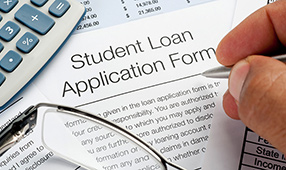Key takeaways
- There are lots of options out there to help finance a college education for your child.
- Federal loans bring many appealing advantages, such as favorable payment terms and interest rates.
- Improving your credit score can pave a smooth path to a great loan.
- Reading the “fine print” can help you choose the best loan.
If you’re looking to get a loan to fund your child’s college education, take heart in the fact that you’re far from alone: About seven of 10 of students who earn bachelor’s degrees from public and private institutions graduate with debt, borrowing an average of nearly $30,000, according to Savingforcollege.com.
Fortunately, there are financing options available from the government, such as the federal Stafford loan. And then there are private alternative/supplemental loans provided by banks, credit unions, state agencies or the schools themselves, often collectively and simply referred to as “private” loans.
Experts frequently recommend federal loans because they offer these appealing advantages:
- Federal loans don’t require payment until graduation. Repayment on a private loan, in contrast, begins while the student is in school, but lenders may offer in-school deferment options.
- Federal loans are fixed, often at lower rates than private loans.
- If you qualify for a need-based subsidized loan, then the government pays all of the interest while your student is enrolled at least half-time.
- If you and/or your student encounter difficulties making federal debt payments, there are options to lower the burden or temporarily postpone it.
Federal loans offer income-based repayment and loan forgiveness for teachers and other public-service vocations. (If you’d like to take advantage of that, you’ll find lots of valuable information from our article here.)
“The federal loans are more affordable, more available and have better repayment terms,” says Mark Kantrowitz, publisher and vice president of research at Savingforcollege.com. “So, if you must borrow, do so with a federal loan first.”
5 steps to a private education loan
Not all families qualify for federal loans. Others may need additional support beyond what the federal programs provide. In these cases, private loans are readily available. Consider these steps to help you evaluate whether to get a private education loan, and how to get one that’s right for you:
1. Determine your “need equation.”
Sean Moore, a Certified Financial Planner (CFP) and founder of SMART College Funding, says it’s critical for families to sit down and do some math to find out what college will actually cost. By the time you’ve listed all of the expenses, you may be delighted to discover that you don’t need a loan at all.
“Parents and their students have to sit down and calculate the true financial need,” Moore says. “Map out all factors contributing to the cost of attendance. You’ll want to include tuition, fees, books, supplies, room, board and an allocation for personal incidentals and transportation costs. Then project the expected household contributions available to pay for these. With this, you can accurately assess what you should borrow, if anything.”
2. Research your options.
School websites may list lenders. But you can go to whichever one you prefer. It’s best to shop around for the most affordable rate, such as those offered by credit unions.
In addition, there are the NEA Student Loan programs, which can help students and their families pay for undergraduate or graduate college expenses that aren’t covered by scholarships, grants or federal loans.
3. Improve your credit profile.
If you go the private route, do everything you can to qualify for good credit to get a great interest rate. Private loans are most commonly packaged as credit-underwritten vehicles, and your child probably hasn’t established a longstanding history of strong credit. “The vast majority of the loans require a credit-worthy co-signer,” Kantrowitz says, and that likely would be you.
4. Calculate the real price tag.
Before deciding upon a loan, read the fine print and find out what the true costs are—including fees charged and whether the interest rate is fixed or will vary over time, Moore says. Then, add up how much the combined fees and rates will cost over time. Private loans usually last anywhere from five to 25 years, with 15 being the most common. Interest rates run the range of 2.25% to 16%.
“The fees extend beyond the interest rate,” he says. “While Loan A may look more attractive, Loan B may actually be cheaper in the long run due to lower fees. (For interest rates), a great deal of lenders will advertise one rate while the student is in school, and then charge a higher rate upon graduation. Any variable rate will result in significantly increased interest at some point in the future.”
5. Lay out a post-graduation debt plan.
Aim for your child to graduate with no more total debt than they’d likely earn as an annual starting salary. That way, he or she can pay it off within 10 years. If not, there are options to eventually pay off the loan.
“This can include income-based repayment or extended repayment, which stretch out terms to make it more affordable month-to-month,” Kantrowitz says.









